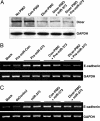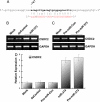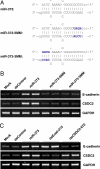MicroRNA-373 induces expression of genes with complementary promoter sequences
- PMID: 18227514
- PMCID: PMC2234192
- DOI: 10.1073/pnas.0707594105
MicroRNA-373 induces expression of genes with complementary promoter sequences
Erratum in
-
Correction for Place et al., MicroRNA-373 induces expression of genes with complementary promoter sequences.Proc Natl Acad Sci U S A. 2018 Apr 3;115(14):E3325. doi: 10.1073/pnas.1803343115. Epub 2018 Mar 19. Proc Natl Acad Sci U S A. 2018. PMID: 29555737 Free PMC article. No abstract available.
Abstract
Recent studies have shown that microRNA (miRNA) regulates gene expression by repressing translation or directing sequence-specific degradation of complementary mRNA. Here, we report new evidence in which miRNA may also function to induce gene expression. By scanning gene promoters in silico for sequences complementary to known miRNAs, we identified a putative miR-373 target site in the promoter of E-cadherin. Transfection of miR-373 and its precursor hairpin RNA (pre-miR-373) into PC-3 cells readily induced E-cadherin expression. Knockdown experiments confirmed that induction of E-cadherin by pre-miR-373 required the miRNA maturation protein Dicer. Further analysis revealed that cold-shock domain-containing protein C2 (CSDC2), which possesses a putative miR-373 target site within its promoter, was also readily induced in response to miR-373 and pre-miR-373. Furthermore, enrichment of RNA polymerase II was detected at both E-cadherin and CSDC2 promoters after miR-373 transfection. Mismatch mutations to miR-373 indicated that gene induction was specific to the miR-373 sequence. Transfection of promoter-specific dsRNAs revealed that the concurrent induction of E-cadherin and CSDC2 by miR-373 required the miRNA target sites in both promoters. In conclusion, we have identified a miRNA that targets promoter sequences and induces gene expression. These findings reveal a new mode by which miRNAs may regulate gene expression.
Conflict of interest statement
The authors declare no conflict of interest.
Figures






References
-
- Fire A, Xu S, Montgomery MK, Kostas SA, Driver SE, Mello CC. Nature. 1998;391:806–811. - PubMed
-
- Elbashir SM, Harborth J, Lendeckel W, Yalcin A, Weber K, Tuschl T. Nature. 2001;411:494–498. - PubMed
-
- Reinhart BJ, Slack FJ, Basson M, Pasquinelli AE, Bettinger JC, Rougvie AE, Horvitz HR, Ruvkun G. Nature. 2000;403:901–906. - PubMed
-
- Llave C, Xie Z, Kasschau KD, Carrington JC. Science. 2002;297:2053–2056. - PubMed
Publication types
MeSH terms
Substances
Grants and funding
LinkOut - more resources
Full Text Sources
Other Literature Sources
Miscellaneous

